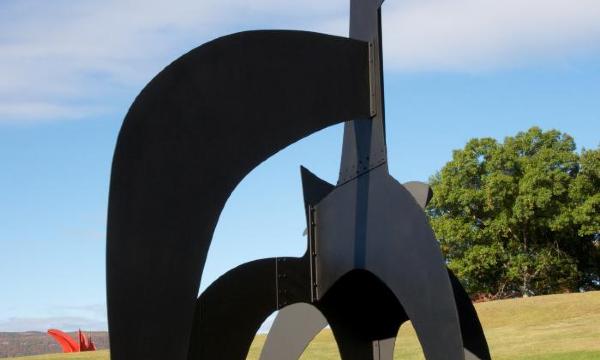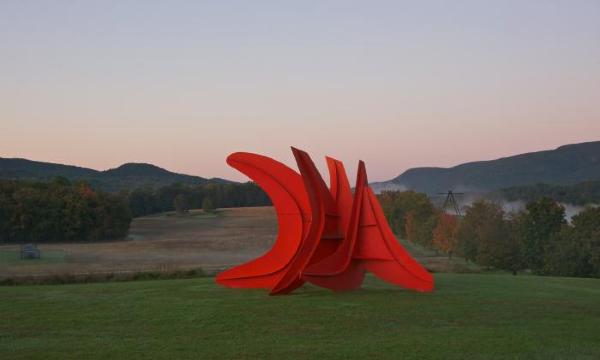On view

American, 1898–1976
The Arch, 1975
Painted steel
50 ft. x 41 ft. 6 in. x 34 ft. 10 in. (15.2 x 12.6 x 10.6 m)
Purchase Fund and gift of the Ralph E. Ogden Foundation
© 2021 Calder Foundation, New York/Artists Rights Society (ARS), New York
Photo by Jerry L. Thompson
Soaring above Storm King’s native grasses, The Arch melds the biomorphic and the architectural, two styles that characterize Alexander Calder’s sculptural work. The monumental structure is composed of three unique steel shapes that form an arch, through which viewers are invited to travel. Located near Storm King’s entrance, The Arch welcomes visitors and announces one of the site’s defining purposes: the presentation of sculpture in nature. Painted entirely black, the surface appears, from some vantage points, to be flat, punctuated by many lines of bolts securing the steel. From other angles, the structurally supportive ribs give the work a sense of movement. Calder based The Arch on a nineteen-inch-high model that he made around 1940. The final work, enlarged from a twelve-foot-high, black-painted steel maquette, was fabricated at Segre’s Ironworks in Waterbury, Connecticut, in 1975, the year before Calder’s death. The Arch arrived at Storm King in spring 1978 as a loan; it was acquired in 1982 and installed on a slightly raised mound, shaped by a few feet of gravel, on a site created by the late William A. Rutherford, Sr., Storm King’s original landscape architect. It stands in the same location today.
Calder is renowned as a pioneer of abstract sculpture. In the mid-1920s he attended the Art Students League of New York, where he produced paintings congruous with the Ashcan aesthetic, a painterly movement influenced by early twentieth-century American industrialization. His artistic sensibility continued to flourish in the heady climate of Paris in the 1920s, where he met and befriended many prominent artists and intellectuals, including Joan Miro, Fernand Leger, James Johnson Sweeney, and the Dada sculptor Marcel Duchamp. He developed a new method of sculpting: by bending and twisting wire, he essentially “drew” three-dimensional figures in space. Calder began making abstract constructions after a visit to the studio of the Dutch painter and art theorist Piet Mondrian in 1930, where he was struck by the environmental installation. In 1931 the artist conceived his first “mobiles,” a term invented by Duchamp to describe Calder’s new kinetic sculptures. In response to Duchamp, Jean Arp, another influential modernist in their circle, dubbed Calder’s motionless constructions “stabiles.” During the 1960s and 1970s, these stabiles gained colossal proportions, appropriate to the public sites for which they were often commissioned.
Calder is renowned as a pioneer of abstract sculpture. In the mid-1920s he attended the Art Students League of New York, where he produced paintings congruous with the Ashcan aesthetic, a painterly movement influenced by early twentieth-century American industrialization. His artistic sensibility continued to flourish in the heady climate of Paris in the 1920s, where he met and befriended many prominent artists and intellectuals, including Joan Miro, Fernand Leger, James Johnson Sweeney, and the Dada sculptor Marcel Duchamp. He developed a new method of sculpting: by bending and twisting wire, he essentially “drew” three-dimensional figures in space. Calder began making abstract constructions after a visit to the studio of the Dutch painter and art theorist Piet Mondrian in 1930, where he was struck by the environmental installation. In 1931 the artist conceived his first “mobiles,” a term invented by Duchamp to describe Calder’s new kinetic sculptures. In response to Duchamp, Jean Arp, another influential modernist in their circle, dubbed Calder’s motionless constructions “stabiles.” During the 1960s and 1970s, these stabiles gained colossal proportions, appropriate to the public sites for which they were often commissioned.


